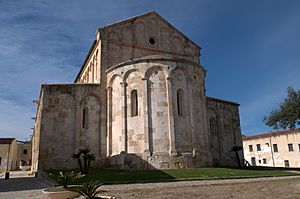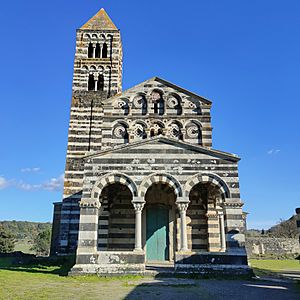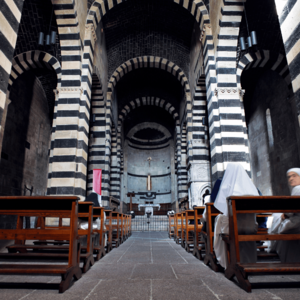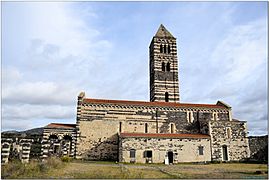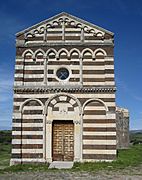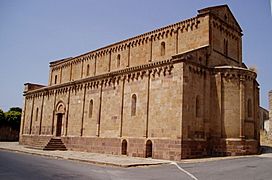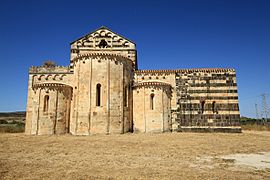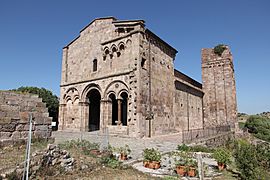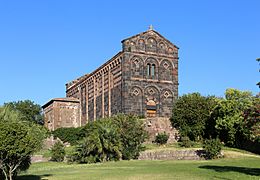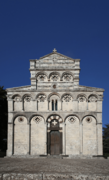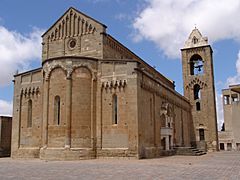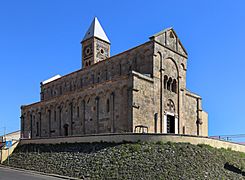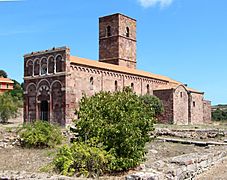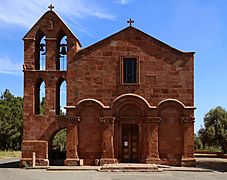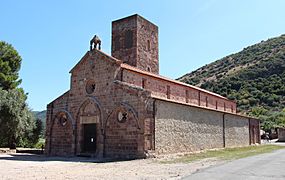Romanesque architecture in Sardinia facts for kids
Romanesque architecture in Sardinia is a special building style that grew on the island of Sardinia. This style became very popular early on, during the time of the Giudicati (local kingdoms). It lasted for a long time. The buildings look unique, but they don't all look the same. This is because many different religious groups came to Sardinia from various parts of Italy and France. Because of this, you can see influences from places like Pisa, Lombardy, and Provence in the buildings. You can also find hints of workers from the Iberian Peninsula who had Islamic cultural backgrounds.
Contents
How Romanesque Architecture Started in Sardinia
The very first Romanesque building on the island is the Basilica of San Gavino in Porto Torres. Its construction began around 1015, during the rule of Judike Gonario I of Torres. This new church was built near an old Christian burial ground and two older churches from the 5th to 7th centuries.
Judike Gonario hired skilled builders from Pisa to help construct it. When he passed away, his son Barisone I of Torres continued the work. The basilica was finished before 1063.
Monks and New Buildings
Barisone I also invited many groups of monks to Sardinia. In 1063, he asked Pope Victor III to send monks from Montecassino. He gave them land and churches, like Santa Maria di Bubalis (now Nostra Segnora de Mesumundu).
Later, in 1089, Constantine I of Cagliari, the Judike of Cagliari, gave the Basilica of San Saturnino to monks from the Abbey of Saint-Victor de Marseille. This was so they could start a monastery.
Over the next few decades, many religious orders arrived. These included the Camaldolese, the Vallombrosians, the Cistercians, and the Victorians. Local wealthy families, called mayorales, also spent a lot of money to build many private churches. This led to a great growth in Romanesque architecture, which developed unique and interesting features on the island.
Key Features of Sardinian Romanesque Buildings
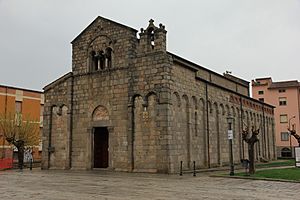
The art historian Giulio Carlo Argan noted that Sardinian Romanesque buildings from the 11th and 12th centuries often blended two new styles: Lombard and Tuscan. This mix created new and exciting designs.
Examples of Mixed Styles
Some churches show this blend of styles. These include San Nicola di Trullas in Semestene (built before 1113) and the royal chapel of Santa Maria del Regno in Ardara (1107). Other examples are San Nicola di Silanis in Sedini (before 1122) and the Basilica of San Simplicio in Olbia (11th-12th century).
Lombard and French Influences
Some buildings show a clear Lombard style, like the Church of San Pietro di Zuri, built by master Anselmo from Como.
Many churches were also built with French influences. These were often for the Marseille monks, using workers from Provence. Sometimes, local Sardinian workers, who had learned in Italy, helped too. Examples include the church of San Platano in Villaspeciosa and San Gemiliano in Sestu. Other churches are San Lorenzo in Cagliari, San Saturnino di Ussana, and the first version of Santa Maria di Uta.
Besides the Benedictines from San Vittore, other groups from beyond the Alps also built churches. These included the Cistercians and the Templars.
Tuscan Style Churches
Many Romanesque churches in Sardinia show a strong Tuscan influence. Famous examples are the Basilica di Saccargia in Codrongianos and the Cathedral of San Pietro di Sorres in Borutta. Other notable churches include Nostra Signora di Tergu, the Cathedral of Santa Giusta in the town of Santa Giusta, and the church of San Nicola di Ottana.
Defensive Structures
Sardinia also has many impressive defensive buildings from this period. These include numerous castles and towers, especially in the city of Cagliari. The Tower of San Pancrazio and the Tower of the Elephant are two famous towers in Cagliari. They were designed by the Sardinian architect Giovanni Capula.
Image gallery
-
Church of San Pietro delle Immagini or del Crocifisso, Bulzi
-
Cathedral of Santa Maria di Monserrato, Tratalias
-
Church of San Michele di Salvènero, Ploaghe
-
Cathedral of Sant'Antioco di Bisarcio, Ozieri
-
San Nicola, Ottana
-
The front of San Pietro di Sorres, Borutta
-
Cathedral of San Pantaleo, Dolianova
-
Cathedral of Santa Giusta, Santa Giusta
-
Nostra signora of Tergu
-
Church of San Pietro di Zuri, Ghilarza
-
Church of San Pietro Extramuros, Bosa
See also
 In Spanish: Arquitectura románica en Cerdeña para niños
In Spanish: Arquitectura románica en Cerdeña para niños


